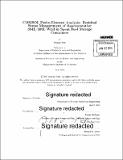COMSOL finite-element analysis : residual stress measurement of representative 304L/308L weld in spent fuel storage containers
Author(s)
Solis, Dominic (Dominic R.)
DownloadFull printable version (5.485Mb)
Other Contributors
Massachusetts Institute of Technology. Department of Nuclear Science and Engineering.
Advisor
Ronald Ballinger.
Terms of use
Metadata
Show full item recordAbstract
The ultimate storage destination for spent nuclear fuel in the United States is currently undecided. Spent fuel will be stored indefinitely in dry cask storage systems typically located on-site at the reactor or at a dedicated independent spent fuel storage installation (ISFSI). Since these canisters were not originally designed or qualified for indefinite storage, there is a need to quantify the length of time they will be viable for storing spent fuel. Stress corrosion cracking (SCC) is a concern in these canisters if they are exposed to an aqueous, chloride-containing film. Canisters are fabricated using a concrete overpacking, along with austenitic stainless steel on the inside which is welded together. One factor that would significantly impact SCC behavior inside these canister welds, if the proper conditions developed such that SCC occurred, is the tensile residual stress profile. As the highest residual stresses are present in the welds and their heat-affected zones (HAZ), it would be useful to investigate their influence by predicting the residual stress profile in the container. These data will support further research into the life expectancy of these canisters and the possible ways in which they might fail due to SCC. Residual stress data for nuclear waste canisters are scarce. Without experimental measurements, initial insight must be attained through computational analysis using finite-element analysis (FEA) packages such as COMSOL. Using a representative 304L/308L weld plate as a model in COMSOL, predicted residual stress shows some agreement with expected trends: high tensile stresses in the weld/ HAZ regions and compressive stresses in the surrounding material. Hardness tests show trends similar to the hardening profiles that were created after the weld simulation. Additionally, the thermal model may offer insight in predicting the HAZ profiles in the weld. While the 2D model is simplified and would benefit from further refinement and validation, preliminary results suggest that FEA could be used for residual stress measurement predictions.
Description
Thesis: S.B., Massachusetts Institute of Technology, Department of Nuclear Science and Engineering, 2014. Cataloged from PDF version of thesis. Includes bibliographical references (pages 30-31).
Date issued
2014Department
Massachusetts Institute of Technology. Department of Nuclear Science and EngineeringPublisher
Massachusetts Institute of Technology
Keywords
Nuclear Science and Engineering.